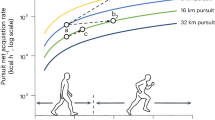Abstract
THE experiments of Lee1 indicate that shearing sheep may, depending on climatic conditions, either increase or decrease the animal's reaction to heat, and that atmospheric temperature and humidity conditions can be divided into two distinct groups on this basis. This work has been confirmed by Klemm2, whose results clearly demonstrate that shorn sheep tolerate hot wet atmospheres better than unshorn sheep, the reverse situation applying under hot dry conditions. In view of these differences, it was of interest to examine the influence of a range of fleece lengths on the reactions of sheep to wet and dry heat.
This is a preview of subscription content, access via your institution
Access options
Subscribe to this journal
Receive 51 print issues and online access
$199.00 per year
only $3.90 per issue
Buy this article
- Purchase on Springer Link
- Instant access to full article PDF
Prices may be subject to local taxes which are calculated during checkout
Similar content being viewed by others
References
Lee, D. H. K., Austral. J. Agric. Res., 1, 200 (1950).
Klemm, G. H., Austral. J. Agric. Res., 13, 472 (1962).
Macfarlane, W. V., Morris, R. J., and Howard, B., Nature, 178, 304 (1956).
Parer, J. T., J. Agric. Sci., Camb., 60, 141 (1963).
Author information
Authors and Affiliations
Rights and permissions
About this article
Cite this article
THWAITES, C. Fleece Length and the Reactions of Sheep to Wet and Dry Heat. Nature 211, 997–998 (1966). https://doi.org/10.1038/211997a0
Issue Date:
DOI: https://doi.org/10.1038/211997a0
This article is cited by
-
Technologies for the automated collection of heat stress data in sheep
Animal Biotelemetry (2021)
Comments
By submitting a comment you agree to abide by our Terms and Community Guidelines. If you find something abusive or that does not comply with our terms or guidelines please flag it as inappropriate.



